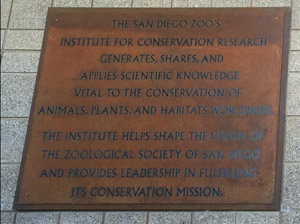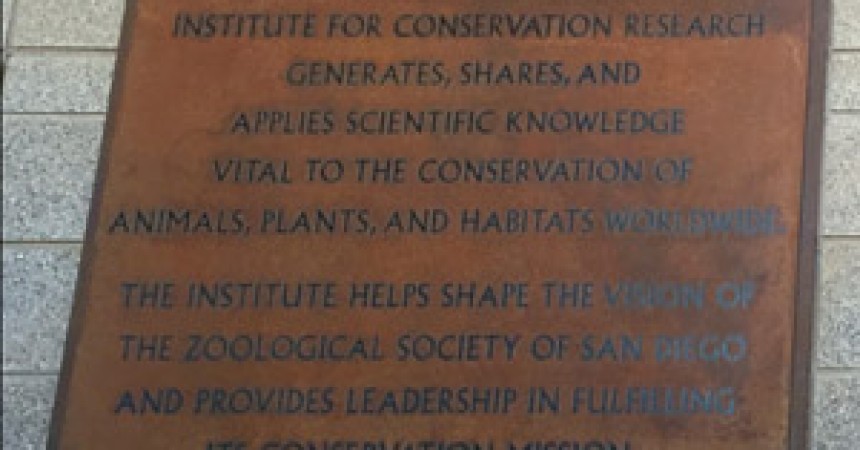Zoo Internquest is a seven-week career exploration program for San Diego County high school juniors and seniors. Students have the unique opportunity to meet professionals working for the San Diego Zoo, Safari Park, and Institute for Conservation Research, learn about their jobs, and then blog about their experience online. Follow their adventures here on the Zoo’s website!
 “The San Diego Zoo’s Institute for Conservation Research generates, shares, and applies scientific knowledge vital to the conservation of animals, plants, and habitats worldwide.” This quote, among many other things, shows how the Institute of Conservation Research is dedicated to conservation. The Institute has eight divisions relating to conservation based at the Beckman Center, and this week interns visited the reproductive physiology division. Interns were introduced to Chris Tubbs, a scientist of more than eight years at the Institute, and Rachel Felton, who is a Senior Research Associate.
“The San Diego Zoo’s Institute for Conservation Research generates, shares, and applies scientific knowledge vital to the conservation of animals, plants, and habitats worldwide.” This quote, among many other things, shows how the Institute of Conservation Research is dedicated to conservation. The Institute has eight divisions relating to conservation based at the Beckman Center, and this week interns visited the reproductive physiology division. Interns were introduced to Chris Tubbs, a scientist of more than eight years at the Institute, and Rachel Felton, who is a Senior Research Associate.
Reproductive physiology is the study of how animals produce offspring. At the Institute for Conservation Research, scientists work to confirm pregnancies and create new ways to increase the reproductive rates of endangered animals that live at the Zoo and Safari Park. Dr. Tubbs and Ms. Felton work closely with environmental chemicals like phytoestrogens, and the effects these chemicals have on reproductive systems. Phytoestrogens are a type of estrogen, which is a hormone that plays a role in female reproductive cycle. Phytoestrogens can be found in many of the plants the Zoo uses in constructing diets for animals. The high levels of phytoestrogen have proved to be linked to low reproduction levels in captivity in many previous studies. Often times, Dr. Tubbs and Ms. Felton work with critically endangered species like the California condor and southern white rhino. Being that many of these species are endangered, if not critically, it is imperative that these studies occur in a timely manner.
Before getting into their work, interns first learned where the scientists receive the cell lines they work with on a daily basis. Cell lines are harvested from tissues of deceased individuals from the Safari Park and San Diego Zoo. To keep these tissue samples viable, the samples must be stored in the Frozen Zoo. The Frozen Zoo is the first and largest storage facility for genetic material such as sperm, eggs, and live tissue. There are over 1,000 different species and 10,000 individuals’ genetic material kept in the tanks that are at -200 degrees Celsius. The genetic material can be stored indefinitely and help bring back species from extinction and take some species off the endangered list.
How does this relate to Dr. Tubbs and Ms. Felton? They use cell lines to test chemicals from the environment on southern white rhino’s cells, as opposed to the individual, to avoid any harm that might come from these chemicals. They can create cell lines by using genetic material stored in the Frozen Zoo. The cells in the lab are injected with hormone receptors that mimic a southern white rhino’s receptors. The way a hormone receptor works is similar to a lock and key mechanism with the hormone acting as the key. However, phytoestrogens are tricking the receptors on cells with a fake key to make the cells react when there is nothing really there.
Dr. Tubbs and Ms. Felton learn how southern white rhino cells react to certain doses of phytoestrogens before it greatly impacts their reproductive levels. They use their findings to show Zoo nutritionists how much of soy the animals should really be ingesting. Now, the Zoo has much lower levels of phytoestrogens in its food supply to keep reproduction rates high, which is important for the endangered southern white rhino.
These environmental chemicals do not just hurt endangered species, but can also harm us. In the ways that phytoestrogens are hurting southern white rhinoceros reproduction rates, BPA chemicals can cause harm to people. BPA’s can be found in plastics like water bottles, medical devices, everyday school supplies, and sports equipment. Dr. Tubbs informed interns that BPA’s can mimic estrogen and hurt us in the long run. Although, fighting for a major cause like saving the southern white rhinoceros seems much more exciting it is definitely worth it to begin small by helping to get rid of products that contain BPA’s. If we teach children that BPA’s are bad it will be easier to teach them about phytoestrogens and how animals can be affected just like humans.
Aliciá, Conservation Team
Week Two, Winter 2016


